Ever hear of .22 snake shot (also known as rat shot)? People will often ask me what this seemingly odd cartridge is good for. Let’s take a look, but first – the shells themselves:
| Cartridge | Purchase Link |
|---|---|
| CCI .22 LR 31gr Shotshell | Optics Planet |
Also, if you find this article informative, consider my book:
Rimfire Rifles: A Buyer’s and Shooter’s Guide.
Now, on to…
My Chipmunk Problem
It was a mid-March morning. Spring had nearly sprung. The day dawned clear and cold, but the sun was still strong enough to ease the chill. Stepping out onto my front porch, a few robins had reappeared and the taste of spring was indeed in the air. Life was good – that is, until I spied… “The Hole.”
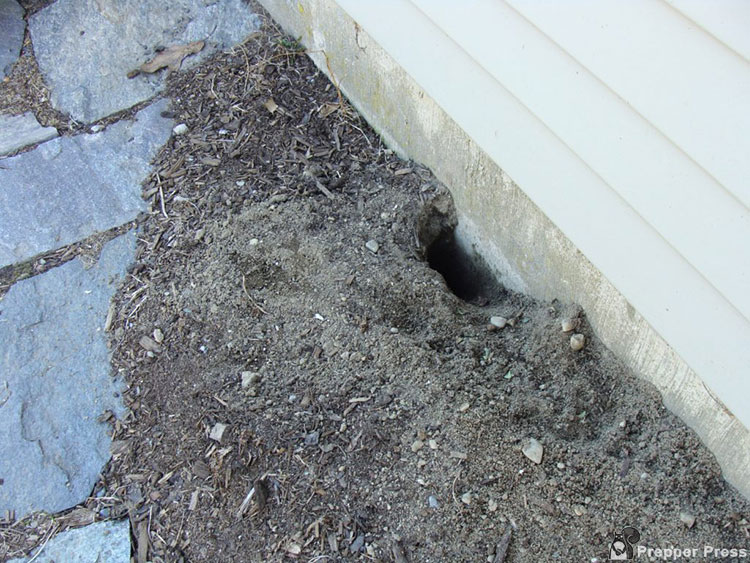
At first I thought, I was seeing things, but nope, it was for real. Fresh dirt was strewn around the small garden beside the house foundation, and a cavernous new excavation had materialized – again!
The latest gopher shenanigans had shades of the old Caddyshack film. In theory at least, my hole-digging nemesis had been terminated the previous fall. That hit had taken some planning, too. Turns out chipmunks become elusive once the “wanted” posters go up.
My wife and I exercised our share of tolerance, refilling the fresh hole that appeared like magic several times each day. Although normally more of an aggravation, the overriding concern was its location. Chip’s front door was hard up against the foundation of our house, directly above the flexible water line that runs from our well.
After a week of tolerance, the prospect of a noshed line and expensive excavation nixed what little compassion remained. It was time for Chip to contract Swiss cheese disease. The trick involved avoiding any collateral damage!
Operation Chip Shot
A rat trap or poison would’ve been hard on our loyal Labrador so I settled on a more discriminate solution: the same .22 Marlin Model 39-A lever-action that had served other permanent eviction notices. Why not a modern airgun? That’s a good pick, too, but chipmunks are furtive little rascals that seldom sit still for long.
Also, this one was apparently sneaky, having never been spied in the act. The numerous others on our property caused no harm, so a total chipmunk cleansing was ruled out. Instead, the plan involved a stakeout at the crime scene. The adjacent concrete foundation and a stone walkway did raise concerns over ricochets, so I went with a proven close-range enforcement solution – a shotgun – but for this purpose, the Marlin would stand in – with a particular type of shell.
I positioned a lawn chair on my porch a few yards from Chip’s doorway with a gas grill serving as my “blind.” The next morning, shortly after sunrise, I slipped into position with a .22 LR rat shot cartridge chambered in the Marlin.
B after an hour of shivering, there was no sign of Chip. I finally quit, unloaded, and filled in the hole with the side of my boot. An hour later The Hole had reappeared. DOH!
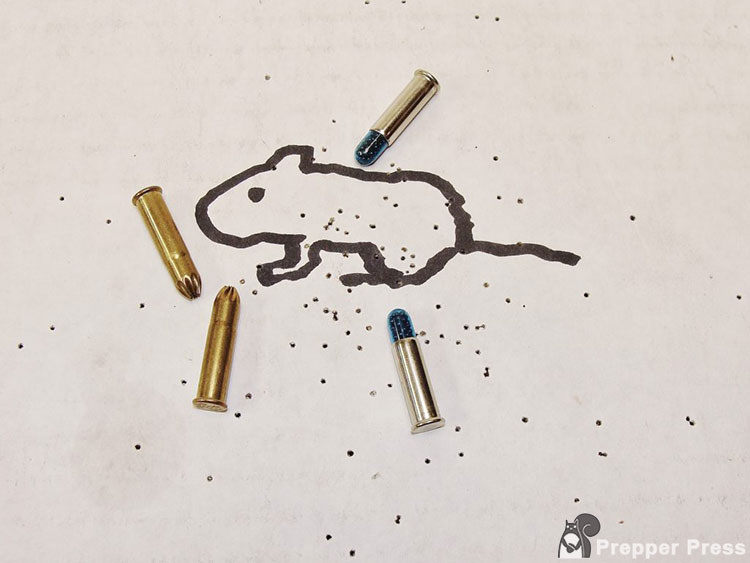
The following morning, I was back before sunup, shivering in the cold but optimistic. As the first welcome rays of sunlight flooded the area, Chip popped out, made a few tentative leaps, and stopped perilously close to a coiled garden hose. No shot!
Finally, one nervous jump put him in the clear long enough to receive a miniscule blast of #12 pellets. Lights out for Chip! Barely a quiver, no collateral damage, and no more worries over subterranean mayhem – or so I thought. I couldn’t resist measuring the range, a measured 4 yards.
What is .22 Snake Shot Good For?
Well, the moniker probably says it best – to a point. Forget upland birds (well, mostly – more on that shortly). Most four-legged critters, too. The chipmunk was fair game only because he was close.
My use case described above gives a good example what it can be used for. The .22 rat shot is perfect for a close-up situation where you need the effect of a shotgun-style pellet pattern with significantly less power.
I’m sure numerous gray squirrels have been blasted off bird feeders, but I’m betting many beyond near-contact distance ran off. Some rats are scary-big and in the same league. However, plenty of small pests including English sparrows, mice, or average rats have been laid low by their namesake, often inside barns with metal roofs.
.22 Rimfire Shot Loads
“Chip” was laid low by a CCI .22 LR shotshell which uses a plastic disintegrating capsule full of tiny #12 shot pellets. The capsule is profiled similarly to a standard 40-grain .22 LR bullet, but contains only 31 grains of shot. Still, this design increases capacity over the more traditional crimped-case types that have been produced for decades. Either type will cycle through the tubular magazine of my Marlin, although I normally just load one or two.
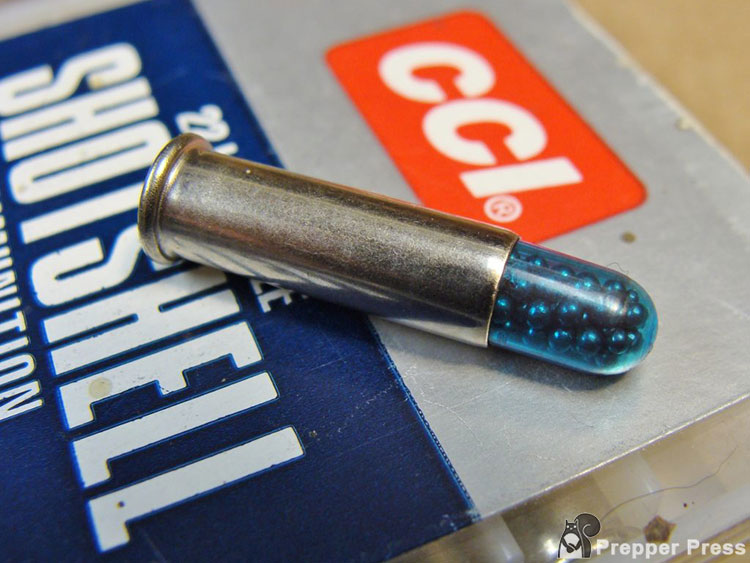
The traditional crimped .22 rat shot loads are another option. The payload of 25 grains is contained within a slightly lengthened brass case, again using #12 shot. When fired, the crimped nose expands to full case-diameter while releasing the pellets.
At that point, it becomes a bit longer than a standard .22 LR. Thus, its mouth might stick in some close-tolerance match chambers, resulting in a failure to extract.
The CCIs won’t stick, but neither type is likely to cycle a semi-auto. The crimped loads are cheaper though, and I’m not sure their performance suffers much. No matter how you slice it, a .22 LR cartridge just can’t contain much shot.
Performance
To offset this disadvantage, .22 rimfire loads contain the tiniest #12 pellets. This includes CCI’s .22 Magnum version, which uses the same shot-capsule technology (enlarged to hold 51 grains). Theoretically, a bunch of tiny pellets should improve pattern density, but physics quickly win out.
The skimpy payloads suffer from the centrifugal effects of rifling, resulting in rapidly thinning patterns. What little pellet energy does exist also rapidly dissipates. By comparison, the lightest 2 ½-inch .410 skeet load seems mighty with ½ ounce (220-grains) of #9s, launched at 1200 fps.
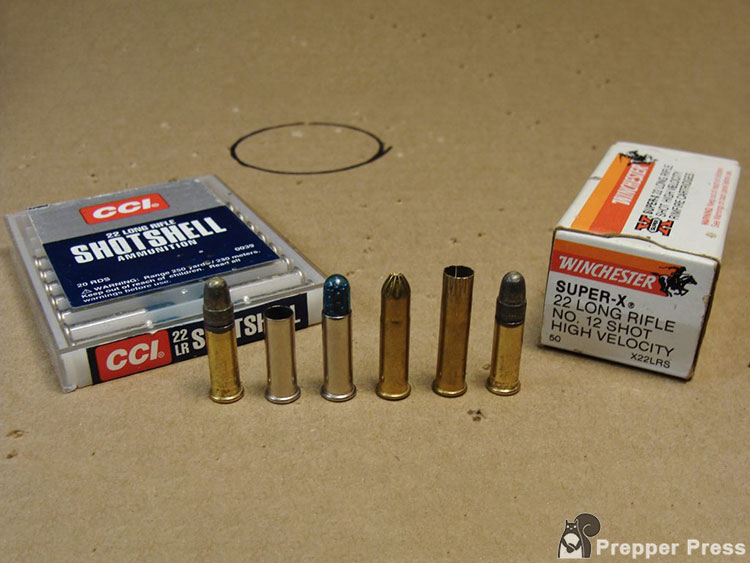
What is the Effective Range of .22 Rat Shot?
The .22 rat shot loads are lucky to break 1000 fps and contain a small payload. This impacts their effective range. Bottome line:
The .22 rat shot drops in power within a few yards and becomes pretty much worthless beyond 10-12 feet. In my experience, seven yards is a practical outer limit. Depending on the performance of the firearm and size of the quarry, you might luck out at 10 yards.
But it can do the trick in tight spaces – especially where collateral damage is a concern. In the Southern U.S. it’s better known as “snake shot.” For my mission it could also be called “chipmunk shot.”
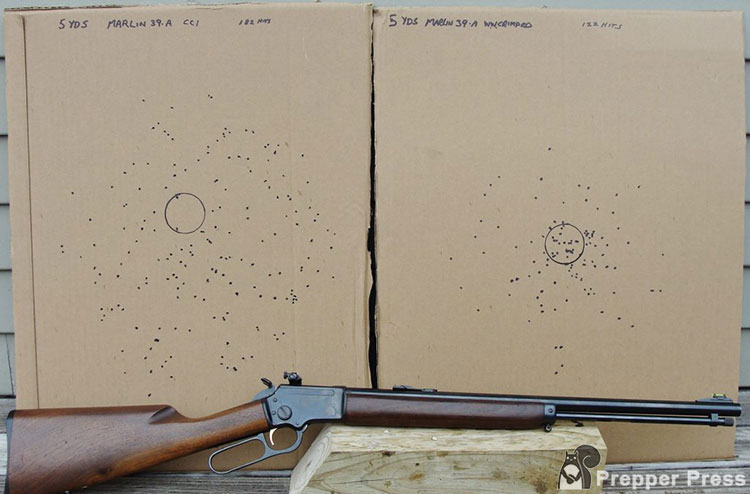
Pigeons would be pushing the envelope for this shot. They may crash land, but they’ll often disappear unless retrieved without delay. That said, where collateral damage is a concern, rat shot can work as long as the distances are close. Crows, which you can eat by the way, should be skipped altogether with rat shot. A starling may be unfortunate enough to receive a few hits, but the pattern will be sparse and low-energy.
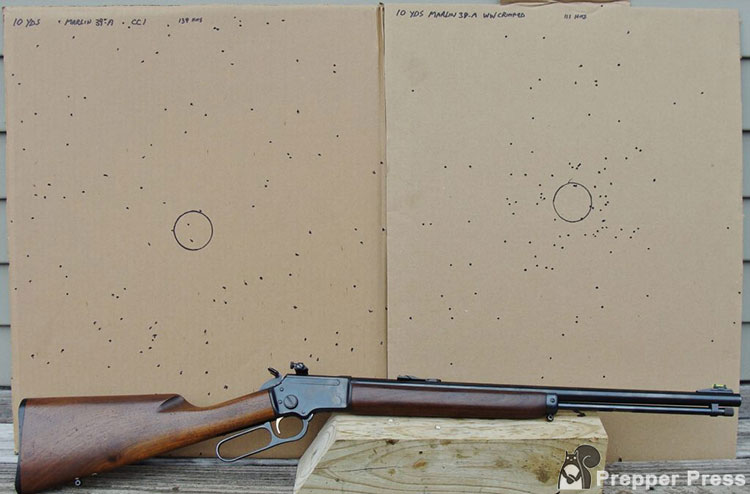
I’d rather stay inside five yards for this reason. I found I could add an extra couple yards by using my older Marlin lever-action, thanks to its Micro-Groove rifling. This type of rifling has numerous shallow lands and grooves which seem to improve patterns a bit over normal designs. It also has a receiver sight, good for fast target acquisition at close range.
Can You Shoot Rat Shot in a Revolver?
Yes, you can shoot .22 rat shot in a revolver. You will find cycling challenges in a pistol, however.
Somewhat paradoxically, handguns sometimes produce better patterns than rifles, possibly due to less rifling abuse. That’s good news for those encountering pests or snakes on the go. My son has lambasted a bunch of mice from the cab of his excavator using an S&W Model 351 PD snubbie stoked with CCI’s .22 WMR load.

But, maybe not…
The mice bail out from its nether regions shortly after the engine starts, presenting tricky targets, and function is assured by using a revolver.
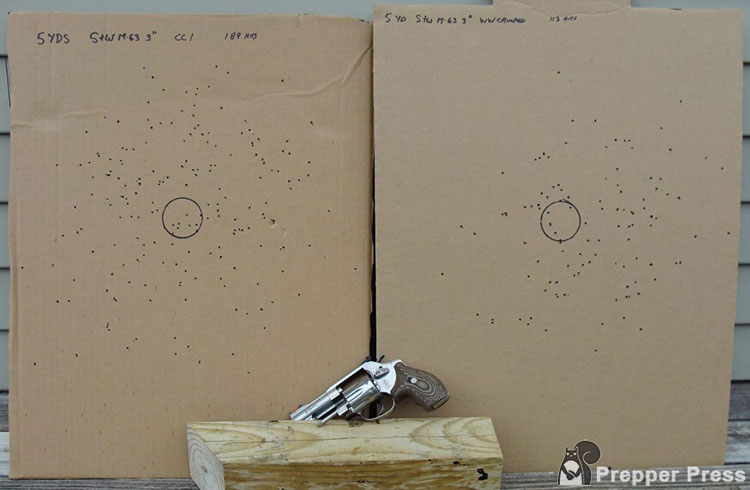
Best of all is a smoothbore “garden gun” built expressly for .22 shot loads. They tend to come and go, but if you can find one, they’ll stretch your range to at least ten yards. A couple recent examples are Marlin’s now discontinued .22 Magnum Model 25MG bolt-action, and Henry’s current .22 LR lever-action Garden Gun. The latter is especially tempting.
Meanwhile, back to the rifled Marlin…
Dale’s Demise (Chipmunk 2.0)
Much later I was into Groundhog Day mode and the outcome was more predictable. I waited for the cold snap to subside, knowing our furry little squatter would be craving strong sunlight. As the first warming rays bathed his spiffy new hole I was ready with the Marlin.
No hose to worry about this time; just bare ground with a clear field of fire. On cue, cousin Dale hopped out in hopes of catching some sun. Instead, he caught a dose of #12s; this time Winchester’s crimped type which were used in the interest of science. Adios to Dale, again at around four yards.
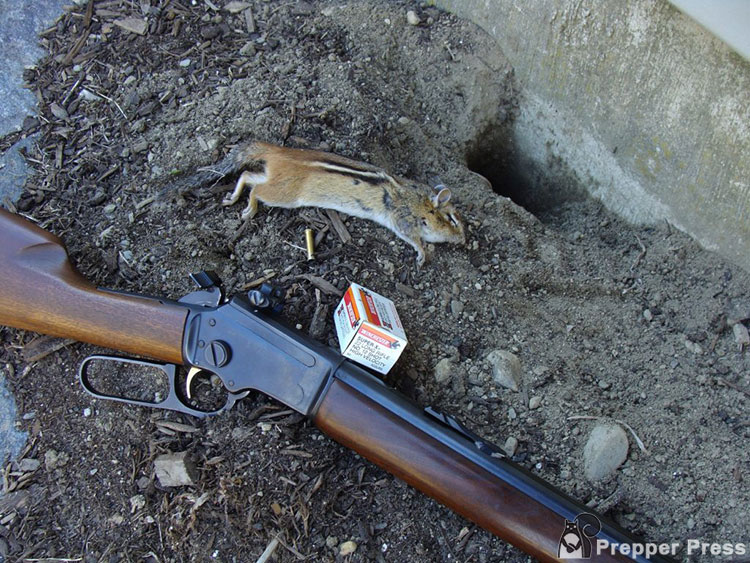
Last Words
Right now ammo of any sort is scarcer than chicken lips. If you can find any bulk ammo deals, seize ’em. Somewhat more potent centerfire shot loads are available in the popular handgun calibers. They fire heavier payloads and some have larger pellets.
As for the rimfires, although I’ve patterned .22 LR shot loads in the past, I decided to sacrifice a few from my precious stash for photos. Overall, the results weren’t surprising although, once again, Winchester’s basic crimped loads were tighter in my Marlin. Turns out, there are some informative videos online. Here’s one:
By the way, I’m the only guy I know who’s hunted quail in his basement. We have no native bobwhites so these were undoubtedly escapees from a nearby game-bird farm. The pair must’ve flown inside when the walk-in basement door was opened.
Rounding them up required my Labrador, a landing net, and an hour of total chaos. As soon as I released them outside, they streaked back inside. I was dumbfounded, but prepared. Tricky shooting though, given all the no-shoot items (one was pruned off the handle of a lawnmower); but 24 hours later, I was quail free. My .22 rat shot had become birdshot, and the dog had two new training aids.

3 comments
I’m looking to buy these snake shot shells. Where do I get them?
There is a link to them right at the beginning of the article.
G’Day from Australia,
I left a comment here yesterday but it seems to have disappeared! Or, I didn’t press SUBMIT! Anyway, I’ll try again.
Thanks for a very amusing but very informative article about rat/snake shot cartridges. I learned more from this article than I have from the many that I have read recently.
A farmer friend of mine has a rat problem in his barn. These rat shot cartridges look like the solution . The shells are readily available at my local gun shop at $30 for a box of 50 Winchesters. About the same as a box of .410 cartridges.
Thanks again & Cheers,
Steve
PS Hopefully this comment sticks around!